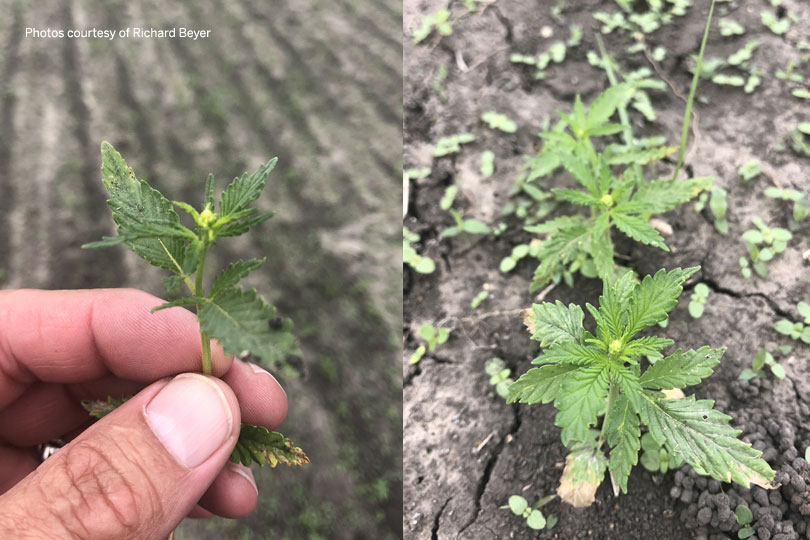By Jennifer Dorsett
Field Editor
The 2018 Farm Bill legalized industrial hemp production for the first time in nearly 100 years, paving the way for Texas farmers to apply for licenses to grow the crop this season.
Hemp has many potential uses from fiber and grain to oil extraction, and while there’s opportunity for much growth in the new market, there’s also much risk.
But in Matagorda County, three Texas Farm Bureau members say they’re up for the challenge.
“This has been a long process in getting ready and leading up to planting. We’ve researched and studied this for over a year now, and finally you just get to the point where you just have to get out there and try it,” Richard Beyer said.
Beyer and fellow farmers Troy Owens and Gary Rooth Jr. first started talking about growing hemp a couple of years ago, after it was announced that legalization of industrial hemp would be included for consideration in the latest farm bill.
Years of depressed commodity prices have left many Texas farmers looking to diversify, and they were no exception.
“We’ve gotten to where there’s a zero margin, or sometimes even less than zero margin on everything else we farm. We’re hoping hemp is a viable rotation for the future,” Owens said.
So, on the morning of March 16, when Texas Department of Agriculture (TDA) opened the hemp-growing license and permit application online, all three applied.
Their licenses were approved, and they began planting their first crop in early May. But despite their careful preparation and research, planting hemp hasn’t been without its challenges.
Rooth said they researched seed varieties prior to planting, but they are unsure of how well the variety they chose will grow in the heavy, clay soils found along the Texas Gulf Coast.
The hemp seed is very fine, similar in size to grain sorghum, and brittle.
Augers and other equipment can crack the seed, so Rooth first attempted planting with a seed cup-type drill. However, the seed cup ground the hemp seed into fine dust, so he switched to a different type of grain drill with 7.5-inch centers.
“We’re learning as we go,” he said. “But the best way to learn is to just get out here in the dirt, put some seeds in the ground and figure it out.”
Germination has also been an issue, according to Rooth. The hemp doesn’t have much vigor, so while it has grown well underneath the soil, the plants have had trouble breaking through the top layer.
“It forms a knuckle and tries to leaf out under the soil, so we ran a CrustBuster across some of it to try to break the crust,” he said.
Heavy rains in mid-May also caused issues for the farmers.
“We had some big rains, and we’re going to have to replant some fields where it washed away,” Owens said. “The stuff that’s up and growing is still in the early stages. We lost more than we’d like, but we’re going to replant and start over.”
They all intend to grow hemp for grain, in part because there’s not a need for additional, specialized equipment.
“Already being farmers and growing other crops, we have the majority of tools and equipment we need for this crop,” Beyer said. “And it’s less hands-on than growing hemp for CBD oil. Planting, cultivating and harvesting can all be done mechanically.”
A buyer has been secured for the grain, but they hope to also find someone who wants to purchase the fiber, making it a dual-purpose crop.
“We decided that starting out and learning this new crop, we’re going to stick to grain production until we know more about how it grows and what to expect,” Beyer said. “I think the grain market and fiber markets are going to be more stable than CBD. And CBD seems like more of a risk. You hear stories of people with warehouses full of (hemp) flowers that they can’t get rid of.”
Hemp fiber has many applications in textiles, rope, paper, bioplastics, insulation and other building uses. Researchers are also studying uses for hemp in livestock feed.
The crop may get some funny looks this year, but the farmers feel as though they’ve prepared themselves and local law enforcement as best as they can, and now they’re focused on the future.
“We know we’ll have inspections from TDA, and the crops will be tested for THC levels throughout the year,” Owens said. “We’ve talked to the sheriff and let him know what we’re growing, and we plan to put signs along the roadway letting people know it’s industrial hemp. We expect there to be some posts on social media about it, but we’re just excited to see what it can do in South Texas.”
The opportunity to try something new and increase profits was too big to pass up, according to Owens.
“We understand it’s going to have challenges, and there’s a lot that we don’t know. We realize that, but we feel like, because it’s a new crop and there’s so many opportunities, it was worth venturing into industrial hemp,” he said.

